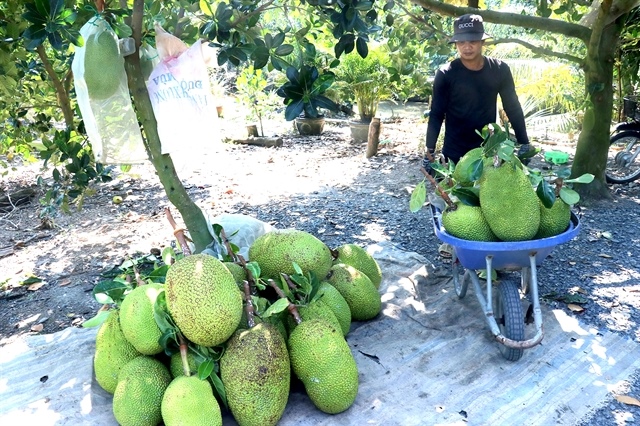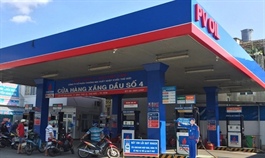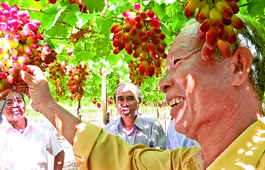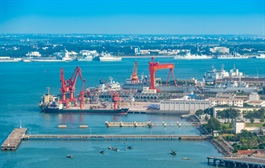Viet Nam sees high growth of fruit exports to China in first five months
Viet Nam sees high growth of fruit exports to China in first five months
Viet Nam's agricultural sector gained strong growth in the export of many kinds of fruit to China in the first five months of 2021, despite the COVID-19 pandemic, according to the Plant Protection Department.

Viet Nam exported over 468,000 tonnes of mangoes to China, 12 per cent higher than the export volume in the whole year of 2020; 348,000 tonnes of bananas, or 87 per cent of the exports in the whole year of 2020; 301,000 tonnes of jackfruit, or 92 per cent of the exports in the whole year of 2020 and 1.1 million tonnes of dragon fruit, or 63 per cent.
According to Hoang Trung, Director of the Plant Protection Department under the Ministry of Agriculture and Rural Development, China is one of the major export markets for Vietnamese agricultural products.
Viet Nam is gradually expanding export markets to the US, EU, Japan and South Korea, but this needs time to achieve the targets as expected, so in the near future, China is still the leading export market with a large proportion of Viet Nam’s farming, forestry and seafood products.
However, China is no longer as easy as it was decades ago, Trung said. With the current development trend, China has more and more standards on the quality of agricultural products imported from any country, including Viet Nam. The requirements include standards for design, packaging, packing specifications, product quality and especially the growing area code.
Therefore, from 2018, the Plant Protection Department has actively worked with localities, businesses and cooperatives nationwide to develop code-granted planting areas to meet China's requirements. So far, Viet Nam has granted codes for 3,400 growing areas of many kinds of fruit exported to many markets. Of which, Viet Nam has granted codes for 1,703 planting areas and 1,776 packing facilities that produce fresh fruit exported to China.
In addition, Viet Nam now exports many kinds of fresh fruit to China under the official export method to take tax advantages under trade agreements, including mango, banana, dragon fruit, longan, lychee, jackfruit, pineapple, watermelon, rambutan and mangosteen.
Viet Nam is negotiating with Chinese partners to reach agreements on the official export of many other kinds of farming products, including sweet potatoes and durian, or waiting for further negotiation for grapefruit, passion fruit and coconut.
However, Trung said Vietnamese agricultural products are currently competing with the agricultural products from Thailand, Cambodia, and even domestic products in the Chinese market.
Trung believed that this forces Viet Nam’s businesses and farmers to cooperate in improving quality, reducing production costs and increasing competitiveness of their agricultural products.
Viet Nam successfully negotiated with China many years ago to have permission to ship farming products under official export, but Viet Nam’s enterprises could not increase exports of those products to China, such as rambutan and mangosteen.
Meanwhile, many other traditional products have gained large exports in recent years, including mango, dragon fruit, and jackfruit. Viet Nam has surpassed the Philippines to become the largest banana supplier to the Chinese market.
Viet Nam expects that when COVID-19 is brought under control, Chinese experts can go to Viet Nam to re-evaluate the technical processes for Vietnamese durian. If gaining permission to ship this product to China under the official export method, Viet Nam could become a competitor with Thailand and Malaysia in exporting durian to China, although those two ASEAN countries have permission on shipping this product under official export to this market for decades.
“To improve the competitiveness of Vietnamese agricultural products, the Plant Protection Department has been implementing many tasks, including biological solutions, organic fertilisers, and programmes granting codes for planting areas, and facilities of packaging, irradiation and hot water treatment. As a result, Vietnamese agricultural products now basically meet the requirements of quality, residue, and cost from strict import markets," said Trung.
According to the Ministry of Agriculture and Rural Development, in the first four months of 2021, the total import and export turnover of agricultural, forestry and fishery products reached more than US$5.57 billion, up 27.8 per cent over the same period in 2020.
Of which, the export value was about $4.02 billion, up 36.5 per cent year on year and the import value reached $1.55 billion, up 9.7 per cent.

























